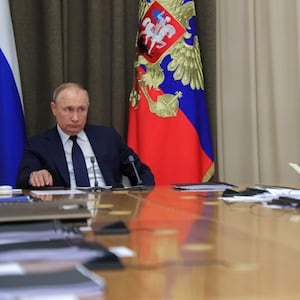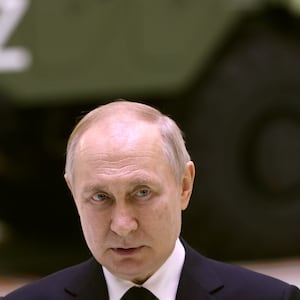The Kremlin has quietly ordered an upgrade to bomb shelters across Russia, according to four former and current Russian officials who spoke with The Moscow Times.
“An order was given from Moscow to carry out this work everywhere—inspection and repair,” one Russian official told the outlet in a report published Monday. Moscow has not publicly announced the updates.
Local authorities have reportedly spent hundreds of millions of rubles on the bomb shelter preparations, which allegedly began in February 2022 after Russia invaded Ukraine. The preparations will reportedly continue this year. And although in some regions authorities have installed signs near the shelters, some authorities have sought to downplay the updates, in an apparent attempt to avoid causing panic.
The demand for bomb shelters in Russia rose last year after Putin announced the “partial mobilization” of troops for the war in Ukraine, according to Russian news outlet 66.RU. The shelters built then would allow people to remain inside them for as long as a year, and could allow people to survive a nuclear explosion. Residents in Moscow, Belgorod, and Kursk have also reportedly been building bomb shelters.
U.S. officials have been warning for weeks that Russia is likely preparing a new offensive. The news comes as Russia prepares to mobilize 300,000 to 500,000 additional troops in the army to run offensive operations in both the south and east of Ukraine, according to a Ukrainian military intelligence assessment released Monday. The operations are expected to take place in the Donetsk and Luhansk regions, as well as in the Zaporizhzhia region.
“This is another obvious sign that Putin's Kremlin has no intention of ending the war,” a representative for the intelligence directorate, Vadim Skibitskyi, said Monday.
The mobilization, which the intelligence branch assesses will last up to two months, is in addition to the “partial mobilization” of 300,000 Russia ordered last fall, which coincided with increased interest in shelters.
The news that the Russian government has initiated updates to bomb shelters throughout the country comes days after the North Atlantic Treaty Organization (NATO) warned that Russia is chipping away at a key nuclear arms control treaty.
Moscow has refused to allow U.S. inspections on its territory since August, and NATO ambassadors said in a statement last week that Russia is failing to comply with its obligations under the New START Treaty. The treaty was meant to establish limits on deployed strategic nuclear warheads, deployed and non-deployed intercontinental ballistic missile launchers, and heavy bombers equipped for nuclear armaments.
Tensions flared last year over whether Moscow would resort to nuclear weapons in the war in Ukraine. Russia accused Ukraine without evidence of preparing a dirty bomb—a weapon with both conventional explosives and radioactive material—as fears mounted that Russian President Vladimir Putin was working to create a justification to use nuclear weapons.
Ukraine’s Main Directorate of Intelligence of Ukraine’s Ministry of Defense announced Monday it is monitoring Russian forces’ nuclear capabilities.
“Ukrainian intelligence constantly monitors the movement of all carriers and monitors active measures that the 12th Main Directorate of the Ministry of Defense of the Russian Federation, which is responsible for the preparation and delivery of nuclear charges to weapons, can conduct or is conducting,” Skibitskyi said.
There are other indications that Russia is preparing for more action in Ukraine. Satellite imagery analysis shared exclusively with The Daily Beast last month showed Russia is preparing to be on defense in Ukraine. The imagery shows Russia has been building fortifications, such as trenches and dragon’s teeth, throughout eastern Ukraine in an apparent attempt to prepare for a Ukrainian counteroffensive and hold onto seized Ukrainian territory.
Some analysts suggested the fortifications buildup could indicate Russia is preparing for a renewed offensive in the new year.
Andriy Chernyak, a representative of the Ukrainian military intelligence branch, said last week that there are some clues that Russia has already begun its new offensive.
Already, the Russians are bringing in more reserves and equipment and building up fortifications in Luhansk, according to Serhii Haidai, the head of the Luhansk Regional Military Administration. A new Russian offensive in the Luhansk region can be expected anytime after Feb. 15, Haidai assessed.
Behind the scenes, however, Moscow is fretting about whether a mobilization will increase domestic dissent over the war, according to a British intelligence assessment.
The General Staff of the Armed Forces of Ukraine has assessed that Russia is relying on recruitment incentives to build up forces in Kherson in Ukraine.
“In order to replenish their manpower losses, the occupiers are also conducting propaganda and agitation work among young people on top of the mobilization. For example, cadet classes with enhanced military training are being created in schools of… Kherson oblast,” a spokesperson for the General Staff of the Armed Forces of Ukraine said Monday. “The Russian invaders promise that the alleged benefit for the graduates of these classes will be entering contract military service at sergeant positions.”
Evgeniy Prigozhin, the leader of Wagner Group, a Russian private mercenary group, has no qualms about relying on prisoners to take up arms and go to the front, according to the White House National Security Council.
“He's not afraid to throw convict after convict into the fight,” National Security Council Coordinator, John Kirby, told reporters on a call Monday.








